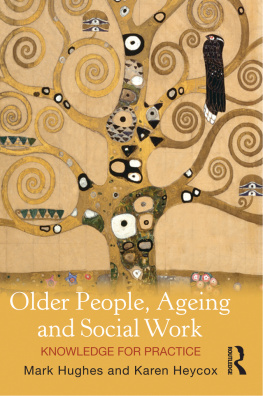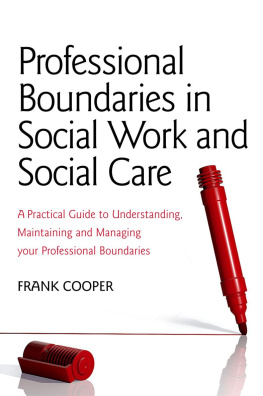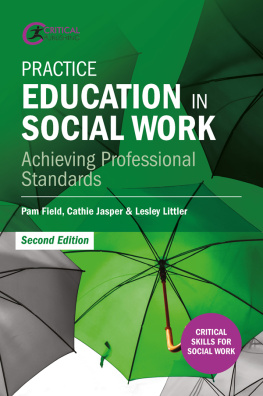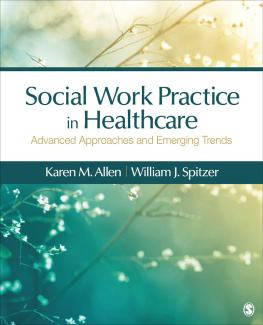First published 1993 by Ashgate Publishing
Published 2017 by Routledge
2 Park Square, Milton Park, Abingdon, Oxon OX14 4RN
52 Vanderbilt Avenue, New York, NY 10017, USA
Routledge is an imprint of the Taylor & Francis Group, an informa business
Copyright Brian J. Taylor and Toni Devine 1993
All rights reserved. No part of this book may be reprinted or reproduced or utilised in any form or by any electronic, mechanical, or other means, now known or hereafter invented, including photocopying and recording, or in any information storage or retrieval system, without permission in writing from the publishers.
Notice:
Product or corporate names may be trademarks or registered trademarks, and are used only for identification and explanation without intent to infringe.
ISBN 13: 978-1-85742-144-6 (pbk)
British Library Cataloguing in Publication Data
Taylor, Brian J.
Assessing Needs and Planning Care
in Social Work
I. Title II. Devine, Toni
361.3
We would like to thank our families for their forbearance with this venture. We are grateful to our colleagues students, managers and trainers for contributing to the development of this text. We are particularly grateful to staff in the following organisations for sharing their practice with us:
Northern Health and Social Services Board
Western Health and Social Services Board
Eastern Health and Social Services Board
Southern Health and Social Services Board
Save the Children Fund
Salvation Army
Catholic Family Care Society
Barnardos
Finally, special thanks to the secretaries who uncomplainingly typed and re-typed this manuscript: Mrs Helen Adams and Miss Siobhan Francis, and also to Mrs Sue Gamble who helped.
The aim of this book is to assist readers in developing skills in caring for people helping them to tackle problems, to learn, to grow, to cope or to change. The focus is on the social work skills required for assessing needs and planning care within a wide variety of practice situations. The book is written in the context of the Community Care systems in the UK (Griffiths, 1988; SSI, 1991a), but the focus on practice skills means that the book is applicable within a wide variety of organisational contexts throughout the world.
Even though systems vary, our key concepts remain:
Assessment of needs and strengths
Planning care to meet needs
Multi-disciplinary working
Monitoring care to ensure a quality service
Evaluation of care provision
Management systems to support staff and develop services.
We see this book as particularly useful to students undertaking qualifying training in social work, but it will also be of value to staff undertaking NVQ qualifications in social and health care. Our premise is that professionals are responsible for assessing needs and planning care, but that other staff will also need skills in contributing to assessment and care planning.
This book has grown out of our joint teaching on a professional training course in social work. Our students have come from work with a range of client groups, and from day care, fieldwork and residential settings. We have drawn our examples (with their consent) from their work in family and child care, mental health, learning disability (mental handicap), physical disability and with elderly people. Here we write about a process which is fundamental to helping another person. That process is not tied to any particular setting although clearly the environment will influence practice. We write about a basic approach, not a particular set of forms to complete. The examples are to illustrate some ways in which the concepts may be applied effectively in practice. They are not put forward as perfect models or as the only way to work.
The potential scope of our subject matter is very broad. We have, therefore, imposed strict limits. First, we focus on the overall process of assessment and care planning. In our teaching programme on skills of working with individuals, a similar amount of time is given to counselling (interaction) skills, to which we refer only briefly here. There are many books available on counselling, and the reader is referred to some of these in the text.
Second, we highlight the social work process across residential, day care and fieldwork settings. This is in keeping with current developments in service delivery where staff are working across such boundaries. Our third focus is on individual care, while recognising social work as an activity which also includes groupwork and the provision of physical care.
A few terms employed need some comment. The person providing help is usually referred to as the social worker, though depending on the context the terms worker, counsellor or helper may also be used. Social worker is never used to make a distinction between a fieldworker and a residential or day care worker. Social work and Social Services are used fairly interchangeably. We tend to refer to the profession as social work and to the statutory employing bodies as Social Services, although we recognise that in Scotland and the Republic of Ireland, these statutory bodies are called Social Work Departments.
The term client refers to the person receiving help. This does not imply a person who is simply done unto, but one who is seeking help and utilising that help. The parallel is with a person utilising legal assistance, where the term client is also common. Finally we avoid repetitious use of the cumbersome he or she and he/she, by using he in the main text, and she in the examples, unless the context is gender specific.
Despite the fact that this book is rooted in our work with students over the years, we believe this publication is particularly timely. Changes in patterns of providing personal social services increasingly require attention to individuals, transcending demarcations between institutions and work settings. In tenns of policy, the development of care in the community (Griffiths, 1988) identifies the centrality of assessing the needs of individuals, and matching services to their needs (NHS and Community Care Act, 1990; People First, DHSS, (NI), 1990). In terms of skills, we utilise the same framework in conceptualising the social work process as that used in the definition of competence of a newly qualified social worker in the UK (CCETSW 1989).
Any change in practice which you intend to implement as an employee of an organisation has implications for others. We suggest, therefore, that you need support for yourself to implement any new approach. We have included inthe final chapter some pointers towards developing practice in staff teams, including residential homes and day centres. Organisational change across whole departments is beyond the scope of this book.
Finally, we recognise the contribution which you, the reader, may make to the development of practice in this area. Contributions and comments would be welome, and should be sent to:
Mr Brian Taylor
c/oArena
Ashgate Publishing Limited
Gower House
Croft Road
Aldershot
Hants GU11 3HR
England







